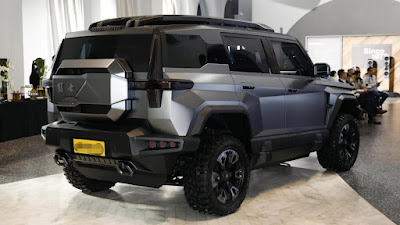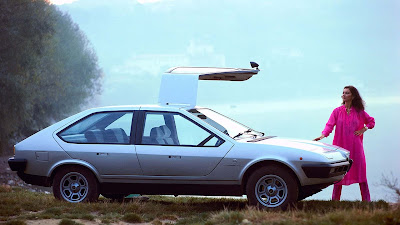Gem from the Past - The world of automotive design is a fascinating realm where creativity and innovation collide to produce vehicles that often push the boundaries of conventional aesthetics. Bruce Mohs, a visionary in this realm, showcased his avant-garde approach with the 1967 Ostentatienne Opera Sedan, now hailed as an eccentric symbol of luxury.
 |
| The Ostentatienne Opera Sedan, crafted by Bruce Mohs in 1967 based on a real International truck chassis, stands as an eccentric symbol of luxury, earning the title of the ultimate 'look-at-me-mobile' during its time. (Picture from: CurbSideClassic) |
Bruce Mohs, primarily known as an entrepreneur with a seaplane service company in Madison, Wisconsin, surprised many with his foray into automobile manufacturing. Priced at $19,600 during its debut, the Ostentatienne Opera Sedan attracted attention despite initial commercial hurdles, thanks to its bold and distinctive design.
 |
| The Mohs Ostentatienne Opera Sedan boasted a real truck chassis from International with a 119″ wheelbase, and measured a massive 90″ wide, 69″ tall, 246″ long, and weighed some 6,100 lbs. (Picture from: CurbSideClassic) |
Unlike typical luxury sedans of its time, the Ostentatienne boasted a real truck chassis from International with a 119″ wheelbase, and measured a massive 90″ wide, 69″ tall, 246″ long, and weighed some 6,100 lbs., extravagant styling, and lavish gold accents. Its sheer presence commanded attention, earning it the moniker of the ultimate "look-at-me-mobile" at the time.
 |
| One of the standout features of the Mohs Ostentatienne Opera Sedan was its distinctive entrance: a fold-up central rear door reinforced with heavy steel girders for enhanced safety. (Picture from: CurbSideClassic) |
One of the defining features of the Ostentatienne was its singular entrance—a fold-up central rear door, complemented by heavy steel girders for safety. Although the interior space was not overly generous, the car offered excellent visibility, thanks to its lack of real pillars and cantilevered roof design.
 |
| While the interior space wasn't expansive, the car provided superb visibility due to its pillar-less design and cantilevered roof. (Picture from: CurbSideClassic) |
Despite being powered by a 250 hp 304 CID V8 engine, some enthusiasts believed that the Ostentatienne deserved a more potent International 549 CID V8, fitting for its imposing stature. The car also boasted luxurious amenities like genuine walnut on the dash, 110V power, a fridge, and unique "isle lights," reminiscent of features found in seaplanes.
 |
| The 1967 Mohs Ostentatienne Opera Sedan was crafted to provide a luxurious and comfortable four-seater driving experience, boasting a 250 hp 304 CID V8 engine. (Picture from: CurbSideClassic) |
Mohs' unconventional designs, including the Ostentatienne and later the Safarikar in 1973, raised eyebrows and sparked discussions about automotive aesthetics and safety. The Safarikar, based on an International Travelall, featured peculiar elements like outward-opening doors on sliding rods, intended for side-impact protection but criticized for being impractical.
 |
| The 1967 Mohs Ostentatienne Opera Sedan also boasted luxurious amenities like genuine walnut on the dash, 110V power, a fridge, and unique "isle lights," reminiscent of features found in seaplanes. (Picture from: CurbSideClassic) |
Despite the initial skepticism and lack of commercial success, Mohs' creations have garnered admiration and curiosity over time. The restoration of the original Ostentatienne prototype in 2009 by Wisconsin high schools breathed new life into this iconic piece of automotive history. After fully restored to its original glory and now resides at Wayne Lensing's Historic Auto Museum in Roscoe, Illinois.
 |
| Bruce Mohs' next eccentric creation, the Safarikar, emerged in 1973, built upon an International Travelall platform, and also boasted unique features such as outward-opening doors on sliding rods. (Picture from: CurbSideClassic) |
In retrospect, Mohs' daring designs may have been ahead of their time, paving the way for future automotive trends and influencing urban automotive culture. The legacy of the Ostentatienne Opera Sedan lives on as a symbol of daring creativity and automotive innovation that continues to inspire enthusiasts and designers alike.
 The story of Bruce Mohs and his unconventional automobiles serves as a reminder that true innovation often comes from daring to break away from the norm and exploring uncharted territories in design and engineering. As automotive enthusiasts, we can only imagine what other visionary creations might emerge in the future, pushing the boundaries of what we perceive as possible in the world of automobiles. *** [EKA | FROM VARIOUS SOURCES | CARTHROTTLE | CURBSIDECLASSIC | THEAUTOPIAN | WIKIPEDIA ]
The story of Bruce Mohs and his unconventional automobiles serves as a reminder that true innovation often comes from daring to break away from the norm and exploring uncharted territories in design and engineering. As automotive enthusiasts, we can only imagine what other visionary creations might emerge in the future, pushing the boundaries of what we perceive as possible in the world of automobiles. *** [EKA | FROM VARIOUS SOURCES | CARTHROTTLE | CURBSIDECLASSIC | THEAUTOPIAN | WIKIPEDIA ]Note: This blog can be accessed via your smart phone.






































